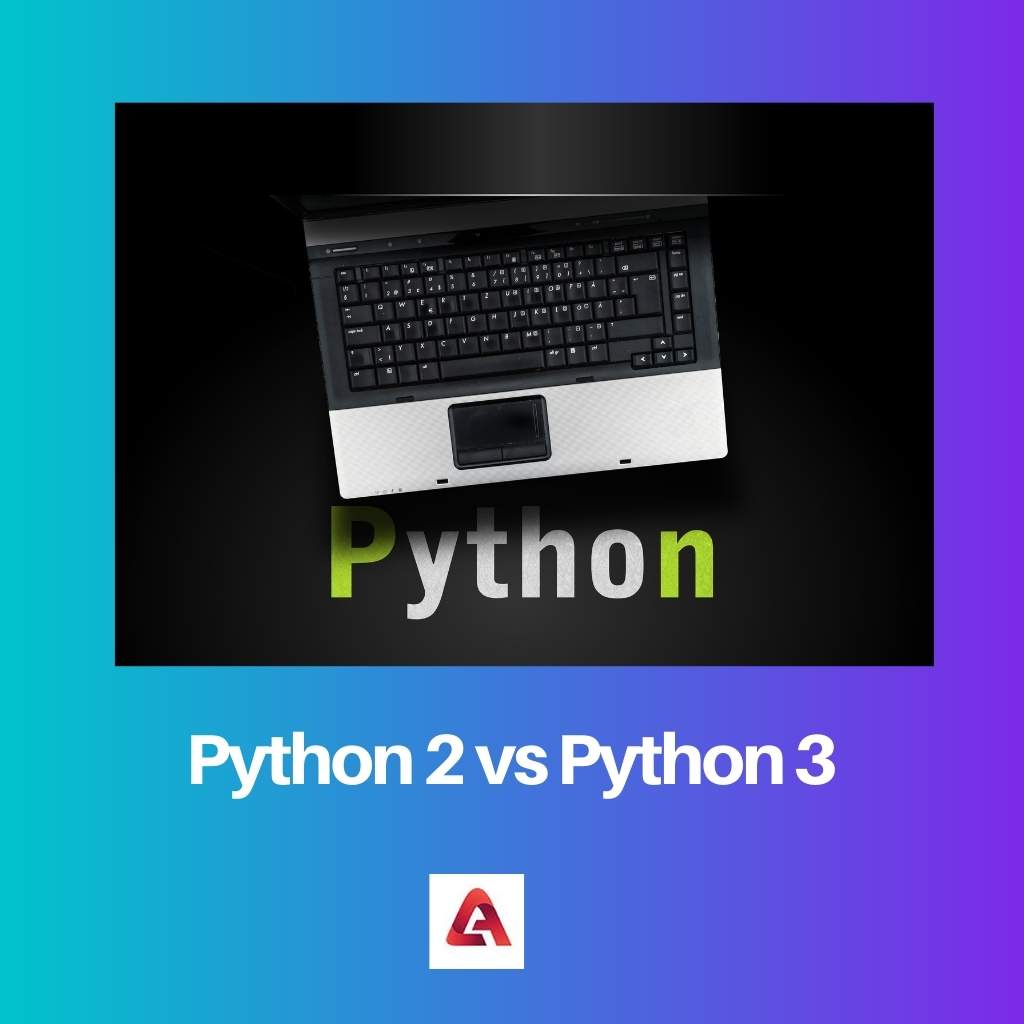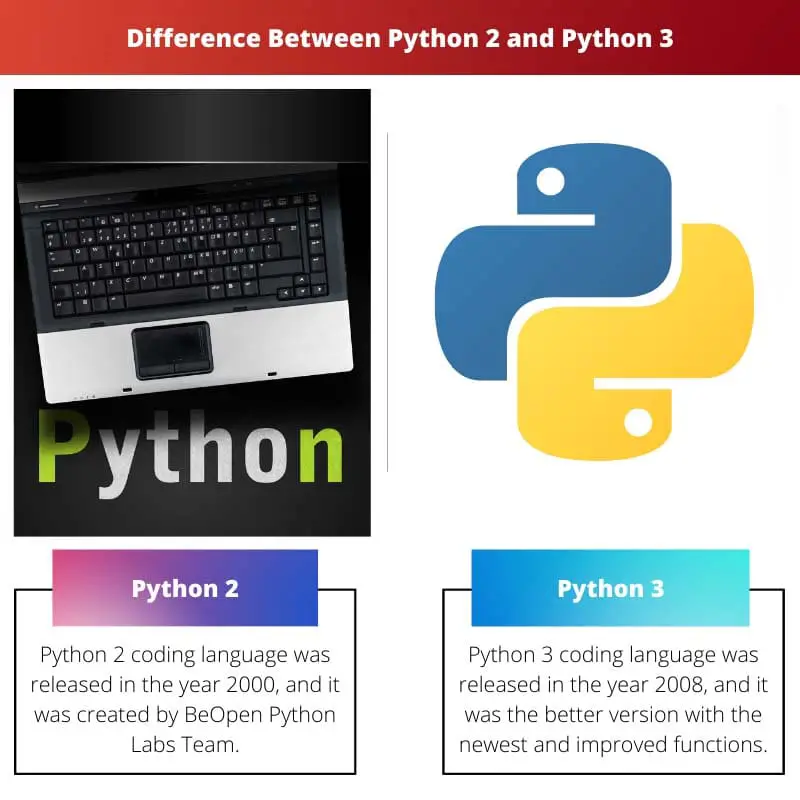The computer is a versatile topic to be discussed. It requires computer programming to run several different applications, programs, etc., to run.
And for that, there are many different languages through which these programs or applications are made of. These may include – C++, Java, Python, PHP, JavaScript, etc.
The people who do this work are known as software engineers or programmers, and some of their main work includes – prototyping, debugging, documentation, integration, software testing, etc.
Key Takeaways
- Python 3 offers improved Unicode support compared to Python 2.
- In Python 3, the print statement has been replaced with the print() function.
- Python 3 uses a new syntax for handling exceptions compared to Python 2.
Python 2 vs Python 3
Python 2 is a programming language released in 2000 with a complex coding language. It is a complicated program for beginners. Python 3 is a new and improved version released in 2008. It is an easy and simple program for beginners.

Python 2 coding language is the heritage of computer programming. This language was released two decades before that, in 2000.
As it was the initial version, it was a bit complex and difficult to understand. This Python 2 version doesn’t require a parenthesis function for its print command.
Also, it does require defining the Unicode value with ‘’u’’ in it.
Python 3 coding language is the better version of the Python language in computer programming. This language was released or launched in the year 2008.
Comparison Table
| Parameters of Comparison | Python 2 | Python 3 |
|---|---|---|
| Released In | 2000 | 2008 |
| General | More complex and difficult | Easy and understandable |
| Print Function | Doesn’t require parenthesis print “hi” | Does require parenthesis for its command print (“hi”) |
| Integer Division | The result of the two digits when divided is the nearest whole integer | The result of the division of the two integers is the perfect integer (may be whole or in decimal) |
| Unicode Support | It codes with “u” as a prefix as it uses ASCII characters being the default encoding. | Being versatile, Unicode is used |
| Xrange | It allows the function to repeat itself | It changes into range() |
| Exception | Enclosed in notation | Enclosed in parenthesis |
| Library | The libraries that are meant for python 2 are not forward-compatible | The libraries for python 3 are still being developed by the programmers, and the limitation for it is that they can only be used for python 3 |
| Rules for Ordering Comparison | Complex | Simple |
What is Python 2?
Python 2 coding language was released in the year 2000, and it was created by BeOpen Python Labs Team.
The main objective or the sole purpose behind creating it was to make it understandable for the average person.
Despite that, Python 2 is a bit complex and difficult for programmers to understand. Also, in the year 2020, the latest version of Python 2 was released, Python 2.7, which is going to be the last update in the series.
There have been numerous libraries created by the programmers for Python 22, but they aren’t forward-compatible.
The Unicode system or strings that are supported by Python 2 are the ASCII character that is a default in them. The divisibility function results in the nearest whole number.
What is Python 3?
Python 3 coding language was released in the year 2008, and it was the better version with the newest and improved functions.
The sole purpose behind creating Python 3 was to make it more compatible with the upgrade versions that it is forward-compatible. Also, it has the function of doing things in just a single way, unlike Python 2.
The Python 3 coding language is easier and simpler to learn and understand by the new programmers. The function of divisibility of integers is quite accurate.
The print function requires an additional parenthesis to work while also denoting any exceptions parenthesis is required. It uses the most versatile Unicode as its default character.
Main Differences Between Python 2 and Python 3
- Python 2 coding language was released two decades ago in the year 2000, on the other hand, python 3 coding language was released in the year 2008.
- Being the initial language, Python 2 is quite more complicated to understand for the programmers that have just started to learn, whereas comparatively, on the other hand, the Python 3 coding language is a bit easier and more understandable for beginner programmers.
- Python 2 coding language doesn’t require an additional print function feature (example-print “hi”), whereas comparatively, on the other hand, the Python 3 coding language requires an additional print function of parenthesis for it [example- print (“hi”)].
- While using Python 2, when two integers are divided like – 3/2, then the result will be the nearest whole number that is 1 and not 1.5 while comparatively, on the other hand, when using Python 3, when two integers are divided, the result of the fraction is the actual number.
- Unicode is the language that is standardized by the international system for encoding characters, and for python 2, it must be used with an “u” as a prefix because the language uses ASCII characters, on the other hand, Python 3 supports the Unicode characters.
- The xrange function in python 2 coding language has a unique feature that it allows the function to repeat itself concurrently while comparatively, on the other hand, the xrange function of the python 3 coding language is that it changes into range().
- The exceptions to be made in the python 2 languages are to be enclosed in notations while comparatively, on the other hand, the exceptions that are to be made in the python 3 coding language are to be enclosed in the parenthesis function.
- There have been libraries made for the python 2 coding language that is not forward-compatible, whereas comparatively, on the other hand, libraries for python 3 coding language are being created by the programmers or software engineers, but the limitation for them is that is they can be only used for python 3.
- The rules for ordering comparison in python 2 coding language are complex and difficult while comparatively, on the other hand, the rules for ordering comparison in python 3 coding language are simple and easy.



